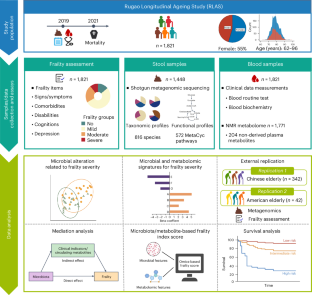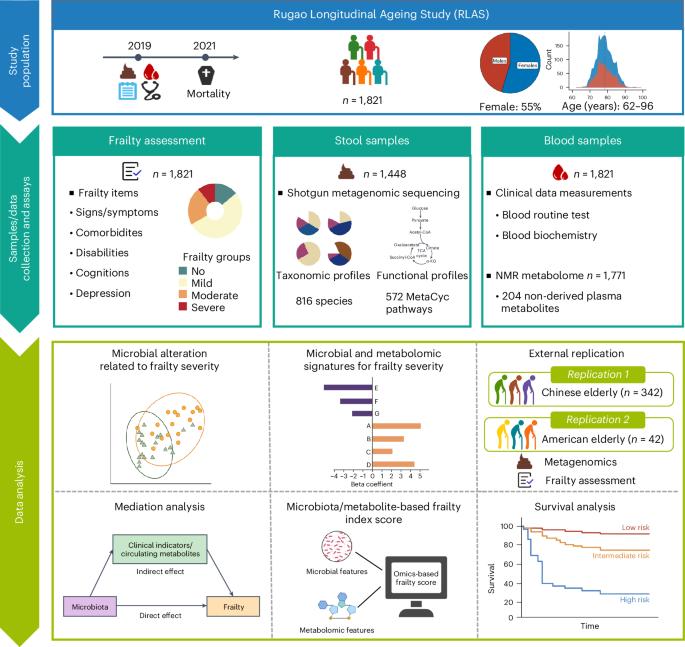Gut microbial features and circulating metabolomic signatures of frailty in older adults
IF 19.4
Q1 CELL BIOLOGY
引用次数: 0
Abstract
Frailty, a multidimensional indicator of suboptimal aging, reflects cumulative declines across multiple physiological systems. Although age-related changes have been reported in gut microbiota, their role in healthy aging remains unclear. In this study, we calculated frailty index (FI) from 33 health-related items to reflect the overall health status of 1,821 older adults (62–96 years, 55% female) and conducted multi-omics analysis using gut metagenomic sequencing data and plasma metabolomic data. We identified 18 microbial species and 17 metabolites shifted along with frailty severity, with stronger links observed in females. The associations of nine species, including various Clostridium species and Faecalibacterium prausnitzii, with FI were reproducible in two external populations. Plasma glycerol levels, white blood cell count and kidney function partially mediated these associations. A composite microbial score derived from FI significantly predicted 2-year mortality (adjusted hazard ratio across extreme quartiles, 2.86; 95% confidence interval, 1.38–5.93), highlighting the potential of microbiota-based strategies for risk stratification in older adults. This study reveals gut microbial and metabolomic features associated with the severity of frailty, demonstrating that these microbial features outperform traditional assessment tools in identifying individuals at high risk of frailty and mortality.


老年人肠道微生物特征和循环代谢组特征与虚弱有关。
虚弱是衰老的一个多维指标,反映了多个生理系统的累积衰退。虽然有报道称肠道微生物群发生了与年龄相关的变化,但它们在健康老龄化中的作用仍不清楚。在这项研究中,我们从 33 个与健康相关的项目中计算出了虚弱指数(FI),以反映 1821 名老年人(62-96 岁,55% 为女性)的总体健康状况,并利用肠道元基因组测序数据和血浆代谢组数据进行了多组学分析。我们确定了 18 种微生物和 17 种代谢物与虚弱严重程度的关系,其中女性与虚弱严重程度的关系更为密切。包括多种梭状芽孢杆菌(Clostridium)和普氏粪杆菌(Faecalibacterium prausnitzii)在内的九种微生物与虚弱严重程度的关系在两个外部人群中具有可重复性。血浆甘油水平、白细胞计数和肾功能在一定程度上介导了这些关联。从 FI 得出的微生物综合评分可显著预测 2 年死亡率(极端四分位数的调整后危险比为 2.86;95% 置信区间为 1.38-5.93),凸显了基于微生物群的老年人风险分层策略的潜力。
本文章由计算机程序翻译,如有差异,请以英文原文为准。
求助全文
约1分钟内获得全文
求助全文

 求助内容:
求助内容: 应助结果提醒方式:
应助结果提醒方式:


